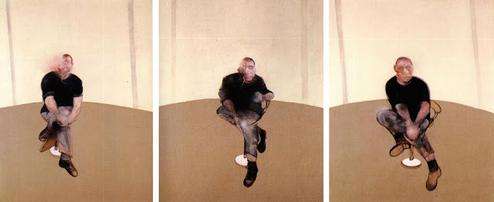Francis Bacon (artist)
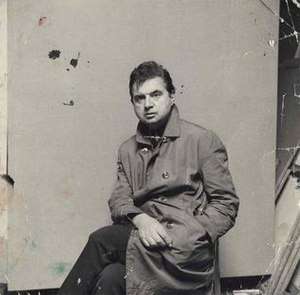
Francis Bacon (28 October 1909 – 28 April 1992) was an Irish-born British figurative painter known for his emotionally charged, raw imagery. He is best known for his depictions of popes, crucifixions and portraits of close friends. His abstracted figures are typically isolated in geometrical cages, set against flat, nondescript backgrounds. Bacon said that he saw images "in series", and his work typically focuses on a single subject for sustained periods, often in triptych or diptych formats. His output can be broadly described as sequences or variations on single motifs; including the 1930s Picasso-influenced bio-morphs and Furies, the 1940s male heads isolated in rooms or geometric structures, the 1950s screaming popes, the mid-to-late 1950s animals and lone figures, the early 1960s crucifixions, the mid to late 1960s portraits of friends, the 1970s self-portraits, and the cooler more technical 1980s paintings.
Bacon took up painting late in life, having drifted in the late 1920s and 1930s as an interior decorator, bon vivant and gambler.[1] He said that his artistic career was delayed because he spent too long looking for subject matter that could sustain his interest. His breakthrough came with the 1944 triptych Three Studies for Figures at the Base of a Crucifixion, which sealed his reputation as a uniquely bleak chronicler of the human condition. From the mid-1960s he mainly produced portraits of friends and drinking companions, either as single or triptych panels. Following the suicide of his lover George Dyer in 1971 his art became more sombre, inward-looking and preoccupied with the passage of time and death. The climax of this later period is marked by masterpieces, including his 1982's "Study for Self-Portrait" and Study for a Self-Portrait—Triptych, 1985–86.
Despite his bleak existentialist outlook, solidified in the public mind through his articulate and vivid series of interviews with David Sylvester, Bacon in person was highly engaging and charismatic, articulate, well-read and openly gay. He was a prolific artist, but nonetheless spent many of the evenings of his middle age eating, drinking and gambling in London's Soho with like-minded friends including Lucian Freud (though the two fell out in the mid-1970s, for reasons neither ever explained), John Deakin, Muriel Belcher, Henrietta Moraes, Daniel Farson, Tom Baker, and Jeffrey Bernard.
After Dyer's suicide he largely distanced himself from this circle, and while his social life was still active and his passion for gambling and drinking continued, he settled into a platonic and somewhat fatherly relationship with his eventual heir, John Edwards. Robert Hughes described Bacon as "the most implacable, lyric artist in late 20th-century England, perhaps in all the world"[2] and along with Willem de Kooning as "the most important painter of the disquieting human figure in the 50s of the 20th century."[3] Francis Bacon was the subject of two Tate retrospectives and a major showing in 1971 at the Grand Palais. Since his death his reputation and market value have grown steadily, and his work is among the most acclaimed, expensive and sought-after. In the late 1990s a number of major works, previously assumed destroyed,[4] including early 1950s popes and 1960s portraits, reemerged to set record prices at auction. In 2013 his Three Studies of Lucian Freud set the world record as the most expensive piece of art sold at auction.
Biography
Early life
Francis Bacon was born on 28 October 1909 in a nursing home in old Georgian Dublin at 63 Lower Baggot Street.[5] His father, Captain Anthony Edward Mortimer ("Eddy") Bacon, was born in Adelaide, South Australia, to an English father and an Australian mother.[6] His father, a veteran of the Boer War, was a racehorse trainer. His mother, Christina Winifred Firth, known as Winnie, was heiress to a Sheffield steel business and coal mine. His father was a descendant of Sir Nicholas Bacon, elder half-brother of Sir Francis Bacon, the Elizabethan statesman, philosopher and essayist.[7] Bacon had an older brother, Harley,[8] two younger sisters, Ianthe and Winifred, and a younger brother, Edward. He was raised by the family's nanny, Jessie Lightfoot, from Cornwall, known as 'Nanny Lightfoot', a maternal figure who remained close to him until her death. Later in his life during the early 1940s, Bacon would rent the ground floor of 7 Cromwell Place, South Kensington, John Everett Millais' old studio, and along with Nanny Lightfoot would install an illicit roulette wheel there, organised by Bacon and his friends, for their financial benefit.
The family moved house often, crossing back and forth between Ireland and England several times, leading to a seance of displacement which remained with Francis throughout his life. The family lived in Cannycourt House in County Kildare from 1911,[8] later moving to Westbourne Terrace in London, close to where Bacon's father worked at the Territorial Force Records Office. They returned to Ireland after the First World War. Bacon lived with his maternal grandmother and step-grandfather, Winifred and Kerry Supple, at Farmleigh, Abbeyleix, County Laois, although the rest of the family again moved to Straffan Lodge near Naas, County Kildare.
Bacon was shy as a child and enjoyed dressing up. This, coupled with his effeminate manner, upset his father. A story emerged in 1992[9] of his father having had Francis horsewhipped by their grooms. In 1924 his parents moved to Gloucestershire, first to Prescott House in Gotherington, then Linton Hall near the border with Herefordshire. At a fancy-dress party at the Firth family home, Cavendish Hall in Suffolk, Francis dressed as a flapper with an Eton crop, beaded dress, lipstick, high heels, and a long cigarette holder. In 1926, the family moved back to Straffan Lodge, His sister, Ianthe, twelve years his junior, recalled that Bacon made drawings of ladies with cloche hats and long cigarette holders.[10] Later that year, Francis was thrown out of Straffan Lodge following an incident in which his father found him admiring himself in front of a large mirror draped in his mother's underwear.[11]
London, Berlin and Paris
Bacon spent the latter half of 1926 in London, on an allowance of £3 a week from his mother's trust fund, reading Nietzsche. Although destitute, Bacon found that by avoiding rent and engaging in petty theft, he could survive. To supplement his income, he briefly tried his hand at domestic service, but although he enjoyed cooking, he became bored and resigned. He was sacked from a telephone answering position at a shop selling women's clothes in Poland Street, Soho, after writing a poison pen letter to the owner. Bacon found himself drifting through London's homosexual underworld, aware that he was able to attract a certain type of rich man, something he was quick to take advantage of, having developed a taste for good food and wine. One was a relative of Winnie, another a breeder of racehorses, Harcourt-Smith, who was renowned for his manliness. Bacon claimed his father had asked this "uncle" to take him 'in-hand' and 'make a man of him'. Francis had a difficult relationship with his father, once admitting to being sexually attracted to him.
In 1927 Bacon moved to Berlin, where he saw Fritz Lang's Metropolis and Sergei Eisenstein's Battleship Potemkin, both later influences. He spent two months in Berlin, though Harcourt-Smith left after one – "He soon got tired of me, of course, and went off with a woman ... I didn't really know what to do, so I hung on for a while." Bacon then spent the next year and a half in Paris. He met Yvonne Bocquentin, pianist and connoisseur, at the opening of an exhibition. Aware of his own need to learn French, Bacon lived for three months with Madame Bocquentin and her family at their house near Chantilly. He travelled into Paris to visit the city's art galleries.[12] At the Château de Chantilly (Musée Condé) he saw Nicolas Poussin's Massacre of the Innocents, a painting which he often referred to in his own later work. From Chantilly, he went to an exhibition that inspired him to take up painting.
Return to London
Bacon returned to London in the winter of 1928/29, where he worked as an interior designer. He took a studio at 17 Queensberry Mews West, South Kensington, sharing the upper floor with Eric Alden – who became his first collector – and his childhood nanny, Jessie Lightfoot. During this period, Bacon advertised himself as a "gentleman's companion" on the front page of The Times.[13] One among the many answers vetted by Nanny Lightfoot came from an elderly cousin of Douglas Cooper, owner of one of the finest collections of modern art in England. The gentleman, having paid Bacon for his services, found him part-time work as a telephone operator in a London club and sought Cooper's help in promoting Bacon's developing skill as a designer of furniture and interiors.
In 1929, while working at the telephone exchange, he met Eric Hall, who became his patron and lover in an often torturous and abusive relationship. Bacon left the Queensberry Mews West studio in 1931 and had no settled space for some years. He probably shared a studio with Roy De Maistre, circa 1931/32 in Chelsea. Portrait (1932) and Portrait (c. 1931–32) both show a round-faced youth with diseased skin.
Furniture and rugs
The 1933 Crucifixion was his first painting to attract public attention, and was in part based on Pablo Picasso's Three Dancers of 1925. It was not well received and, disillusioned, he abandoned painting for nearly a decade, and suppressed his earlier works.[14] He visited Paris in 1935 where he bought a secondhand book on anatomical diseases of the mouth containing high quality hand-coloured plates of both open mouths and oral interiors, which haunted and obsessed him for the remainder of his life. In 1935 he saw Eisenstein's Battleship Potemkin,[15] the scene of the nurse screaming on the Odessa steps and others later becoming a recurrent part of Bacon's iconography and a major theme in his paintings, with the angularity of Eisenstein's images often combined with the thick red palette of his recently purchased medical tome.
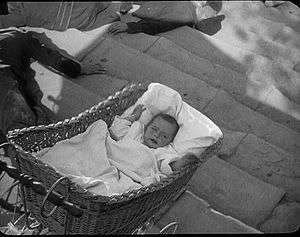
In the winter of 1935–36, Roland Penrose and Herbert Read, making a first selection for the International Surrealist Exhibition, visited his studio at 71 Royal Hospital Road, Chelsea saw "three or four large canvases including one with a grandfather clock", but found his work "insufficiently surreal to be included in the show". Bacon claimed Penrose told him "Mr. Bacon, don't you realise a lot has happened in painting since the Impressionists?" In 1936 or 1937 Bacon moved from 71 Royal Hospital Road to the top floor of 1 Glebe Place, Chelsea, which Eric Hall had rented. The following year, Patrick White moved to the top two floors of the building where De Maistre had his studio, on Eccleston Street and commissioned from Bacon, by now a friend, a writing desk (with wide drawers and a red linoleum top). Expressing one of his basic concerns from the late 1930s, Bacon said that his artistic career was delayed because he spent too long looking for subject matter that could sustain his interest.[16]
In January 1937, at Thomas Agnew and Sons, 43 Old Bond Street, London, Bacon exhibited in a group show, Young British Painters, which included Graham Sutherland and Roy De Maistre. Eric Hall organised the show. Four works by Bacon were shown: Figures in a Garden (1936), purchased by Diana Watson; Abstraction, and Abstraction from the Human Form, known from magazine photographs. They prefigure Three Studies for Figures at the Base of a Crucifixion (1944) in alternatively representing a tripod structure (Abstraction), bared teeth (Abstraction from the Human Form), and both being biomorphic in form. Seated Figure is lost.
On 1 June 1940 Bacon's father died. Bacon was named sole Trustee/Executor of his father's will, which requested the funeral be as "private and simple as possible". Unfit for active wartime service, Francis volunteered for civil defence and worked full-time in the ARP (Air Raid Precautions) rescue service; the fine dust of bombed London worsened his asthma and he was discharged. At the height of the Blitz, Eric Hall rented a cottage for Bacon and himself at Bedales Lodge in Steep, near Petersfield, Hampshire. Figure Getting Out of a Car (ca. 1939/1940) was painted here but is known only from an early 1946 photograph taken by Peter Rose Pulham. The photograph was taken shortly before the canvas was painted over by Bacon and retitled Landscape with Car. An ancestor to the biomorphic form of the central panel of Three Studies for Figures at the Base of a Crucifixion (1944), the composition was suggested by a photograph of Hitler getting out of a car at one of the Nuremberg rallies. Bacon claims to have "copied the car and not much else".[17]
Bacon and Hall in 1943 took the ground floor of 7 Cromwell Place, South Kensington, John Everett Millais' old house and studio. High vaulted and north lit, its roof was recently bombed – Bacon was able to adapt a large old billiard room at the back as his studio. Lightfoot, lacking an alternative location, slept on the kitchen table. They held Illicit roulette parties, organised by Bacon with the assistance of Hall.
Early success
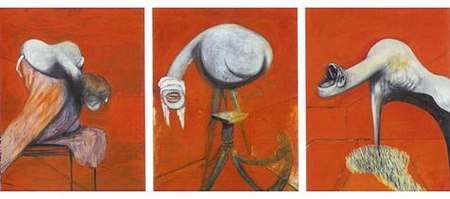
By 1944 Bacon had gained confidence. His Three Studies for Figures at the Base of a Crucifixion had summarised themes explored in his earlier paintings, including his examination of Picasso's biomorphs, his interpretations of the Crucifixion, and the Greek Furies. It is generally considered his first mature piece;[18] he regarded his works before the triptych as irrelevant. The painting caused a sensation when exhibited in 1945 and established him as a foremost post-war painter. Remarking on the cultural significance of Three Studies, John Russell observed in 1971 that "there was painting in England before the Three Studies, and painting after them, and no one ... can confuse the two."[19]
Painting (1946) was shown in several group shows including in the British section of Exposition internationale d'art moderne (18 November – 28 December 1946) at the Musée National d'Art Moderne, for which Bacon travelled to Paris. Within a fortnight of the sale of Painting (1946) to the Hanover Gallery Bacon used the proceeds to decamp from London to Monte Carlo. After staying at a succession of hotels and flats, including the Hôtel de Ré, Bacon settled in a large villa, La Frontalière, in the hills above the town. Hall and Lightfoot would come to stay. Bacon spent much of the next few years in Monte Carlo apart from short visits to London. From Monte Carlo, Bacon wrote to Graham Sutherland and Erica Brausen. His letters to Brausen show he painted there, but no paintings are known to survive. Bacon said he became "obsessed" with the Casino de Monte Carlo, where he would "spend whole days." Falling in debt from gambling here, he was unable to afford a new canvas. This compelled him to paint on the raw, unprimed side of his previous work, a practice he kept throughout his life.[20]
In 1948, Painting (1946) sold to Alfred Barr for the Museum of Modern Art in New York for £240. Bacon wrote to Sutherland asking that he apply fixative to the patches of pastel on Painting (1946) before it was shipped to New York. Painting (1946) is now too fragile to be moved from MoMA for exhibition elsewhere. At least one visit to Paris in 1946 brought Bacon into more immediate contact with French postwar painting and Left Bank ideas such as Existentialism.[21] He had, by this time, embarked on his lifelong friendship with Isabel Rawsthorne, a painter closely involved with Giacometti and the Left Bank set. They shared many interests including ethnography and classical literature.[22]
Late 1940s
In 1947, artist Graham Sutherland introduced Bacon to Erica Brausen, who represented Bacon for twelve years. Despite this, Bacon did not mount a one-man show in Brausen's Hanover Gallery until 1949.[23] Bacon returned to London and Cromwell Place late in 1948. Head I was shown at the Summer Exhibition at the Redfern gallery from July to September 1948. The following spring Head I was displayed at the Hanover Gallery. Between 8 November and 10 December 1949 at the Hanover Gallery, Francis Bacon: Paintings; Robert Ironside: Coloured Drawings, was his first one-man show. It included Head I to Head VI, Study from the Human Body (1949) and Study for Portrait (1949) and four other paintings. Bacon's work attracted the support of Wyndham Lewis writing in The Listener. "The Hanover [Gallery] Show is of exceptional importance. Of the younger painters none actually paints so beautifully as Francis Bacon", Lewis wrote, adding: "Bacon is one of the most powerful artists in Europe today and he is perfectly in tune with his time".[24]
The following year Bacon exhibited his "Heads" series, most notable for Head VI, Bacon's first surviving engagement with Velázquez's Portrait of Pope Innocent X (three 'popes' were painted in Monte Carlo in 1946 but were destroyed). The Cobalt Violet mozzetta, crimson in Velázquez's painting, may reflect Bacon's use of reproductions of the painting. Bacon said that although he admired "the magnificent colour" of the Velázquez, Velázquez "wanted to make it as much like a Titian as possible but, in a curious way he cooled Titian", that is, made Titian more accessible to contemporary audiences. Of the old masters, Bacon favored Titian, Rembrandt, Velázquez, and Francisco Goya's late works. and thought highly of Paul Cézanne He kept an extensive inventory of images for source material, but preferred not to confront the major works in person; he viewed Portrait of Innocent X only once, much later in his life.[25]
1950s
The Colony Room was a private drinking club at 41 Dean Street in Soho, known as "Muriel's" after Muriel Belcher, its proprietor. Belcher had run the Music-box club in Leicester Square during the war, and secured a 3 – 11pm drinking licence for the Colony Room bar as a private-members club; public houses had to, by law, close at 2:30 pm. Bacon was a founding member, joining the day after its opening in 1948. He was 'adopted' by Belcher as a 'daughter', and allowed free drinks and £10 a week to bring in friends and rich patrons. In 1948 he met John Minton, a regular at Muriel's, as were the painters Lucian Freud, Frank Auerbach, Patrick Swift and the Vogue photographer, John Deakin. In 1950, Bacon met the art critic David Sylvester, then best known for his writing on Henry Moore and Alberto Giacometti. Sylvester had admired and written about Bacon since 1948. Bacon's artistic inclinations in the 1950s moved towards his abstracted figures which were typically isolated in geometrical cage-like spaces, and set against flat, nondescript backgrounds. Bacon said that he saw images "in series", and his work typically focused more on a single subject for sustained periods, often in triptych or diptych formats. Although his decisions might have been driven by the fact that in the 50s he tended to produce group works for specific showings, usually leaving things to the last minute, there is significant development in his aesthetic choices during the 1950s which influenced his artistic preference for the represented content in his paintings.
Bacon was impressed by Goya, African landscapes and wildlife, and took photographs in Kruger National Park. On his return journey he spent a few days in Cairo, and wrote to Erica Brausen of his intent to visit Karnak and Luxor, and then travel via Alexandria to Marseilles. The visit confirmed his belief in the supremacy of Egyptian art, embodied by the Sphinx. He returned in spring 1951.
On 30 April[26] 1951, Jessie Lightfoot, his childhood nanny, died at Cromwell Place. Bacon was gambling in Nice when he learned of her death. She had been his closest companion, joining him in London on his return from Paris, and lived with him and Eric Alden at Queensberry Mews West, and later with him and Eric Hall at the cottage near Petersfield, in Monte Carlo and at Cromwell Place. Stricken, Bacon sold the 7 Cromwell Place apartment.
In 1958 he aligned with the Marlborough Fine Art gallery, who remained as his sole dealer until 1992. In return for a 10-year contract, Marlborough advanced him money against current and future paintings, with the price of each determined by its size. A painting measuring 20 inches by 24 inches was valued at £165 ($462), while one of 65 inches by 78 inches was valued at £420 ($1,176); these were sizes Bacon favoured. According to the contract, the painter would try to supply the gallery with £3,500 ($9,800) worth of pictures each year.[27]
Early 1960s

Bacon met George Dyer in 1963 at a pub,[28] although a much-repeated myth claims their acquaintance started during the younger man's burglary into the artist's apartment.[29] Dyer was about 30 years old, from London's East End. He came from a family steeped in crime, and had till then spent his life drifting between theft, detention and jail. Bacon's earlier relationships had been with older and tumultuous men. His first lover, Peter Lacy, tore up the artist's paintings, beat him in drunken rages, at times leaving him on streets half-conscious.[30] Bacon was now the dominating personality; attracted to Dyer's vulnerability and trusting nature. Dyer was impressed by Bacon's self-confidence and success, and Bacon acted as a protector and father figure to the insecure younger man.[31]
Dyer was, like Bacon, a borderline alcoholic and similarly took obsessive care with his appearance. Pale-faced and a chain-smoker, Dyer typically confronted his daily hangovers by drinking again. His compact and athletic build belied a docile and inwardly tortured personality. The art critic Michael Peppiatt describes him as having the air of a man who could "land a decisive punch". Their behaviours eventually overwhelmed their affair, and by 1970 Bacon was merely providing Dyer with enough money to stay more or less permanently drunk.[31]
As Bacon's work moved from the extreme subject matter of his early paintings to portraits of friends in the mid-1960s, Dyer became a dominating presence in the artist's work.[32] Bacon's treatment of his lover in these canvases emphasised his subject's physicality while remaining uncharacteristically tender. More than any other of the artist's close friends portrayed during this period, Dyer came to feel inseparable from his effigies. The paintings gave him stature, a raison d'etre, and offered meaning to what Bacon described as Dyer's "brief interlude between life and death".[33] Many critics have cited Dyer's portraits as favourites, including Michel Leiris and Lawrence Gowing. Yet as Dyer's novelty diminished within Bacon's circle of sophisticated intellectuals, the younger man became increasingly bitter and ill at ease. Although Dyer welcomed the attention the paintings brought him, he did not pretend to understand or even like them. "All that money an' I fink they're reely 'orrible", he observed with choked pride.[34]
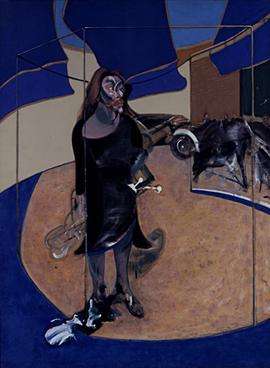
Dyer abandoned crime but soon descended into alcoholism. Bacon's money attracted hangers-on for massive benders around London's Soho. Withdrawn and reserved when sober, Dyer was highly animated and aggressive when drunk, and often attempted to "pull a Bacon" by buying large rounds and paying for expensive dinners for his wide circle. Dyer's erratic behaviour inevitably wore thin with his cronies, with Bacon, and with Bacon's friends. Most of Bacon's art world associates regarded Dyer as a nuisance – an intrusion into the world of high culture to which their Bacon belonged.[35] Dyer reacted by becoming increasingly needy and dependent. By 1971, he was drinking alone and only in occasional contact with his former lover.
In October 1971, Dyer joined Bacon in Paris for the opening of the artist's retrospective at the Grand Palais. The show was the high point of Bacon's career to date, and he was now described as Britain's "greatest living painter". Dyer was a desperate man, and although he was "allowed" to attend, he was well aware that he was slipping out of the picture. To draw Bacon's attention, he planted cannabis in his flat and phoned the police,[36] and attempted suicide on a number of occasions.[37] On the eve of the Paris exhibition, Bacon and Dyer shared a hotel room, but Bacon was forced escape in disgust to the room of gallery employee Terry Danziger-Miles, as Dyer was entertaining an Arab rent boy with "smelly feet". When Bacon returned to his room the next morning, together with Danziger-Miles and Valerie Beston, they discovered Dyer in the bathroom dead, sat on the toilet. With the agreement of the hotel manager, the party agreed not to announce the death for two days.[38]
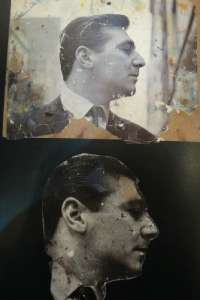
Bacon spent the following day surrounded by people eager to meet him. In mid-evening of the following day he was "informed" that Dyer had taken an overdose of barbiturates and was dead. Bacon continued with the retrospective and displayed powers of self-control "to which few of us could aspire", according to Russell.[39] Bacon was deeply affected by the loss of Dyer, and had recently lost four other friends and his nanny. From this point, death haunted his life and work.[40] Though outwardly stoic at the time, he was inwardly broken. He did not express his feelings to critics, but later admitted to friends that "daemons, disaster and loss" now stalked him as if his own version of the Eumenides (Greek for The Furies).[41] Bacon spent the remainder of his stay in Paris attending to promotional activities and funeral arrangements. He returned to London later that week to comfort Dyer's family.
During the funeral many of Dyer's friends, including hardened East-End criminals, broke down in tears. As the coffin was lowered into the grave one friend was overcome and screamed "you bloody fool!" Bacon remained stoic during the proceedings, but in the following months suffered an emotional and physical breakdown. Deeply affected, over the following two years he painted a number of single canvas portraits of Dyer, and the three highly regarded "Black Triptychs", each of which details moments immediately before and after Dyer's suicide.[42]
Death
While holidaying in Madrid in 1992, Bacon was admitted to the Handmaids of Maria, a private clinic, where he was cared for by Sister Mercedes. His chronic asthma, which had plagued him all his life, had developed into a respiratory condition and he could not talk or breathe very well.
He died of a heart attack on 28 April 1992; attempts to resuscitate him having failed. He had bequeathed his estate (then valued at £11 million) to John Edwards and Brian Clark, executors. In 1998 the director of the Hugh Lane Gallery in Dublin secured the donation of the contents of Bacon's chaotic studio at 7 Reece Mews, South Kensington.[43] The contents of his studio were moved and reconstructed in the gallery.[44]
A collection of drawings, some consisting of little more than scribbles given by Bacon to his driver and handyman Barry Joule, possibly to be destroyed, surfaced in 1998, when Joule handed them over to the Tate Gallery. According to Joule the items were given as a gift.[45] Their artistic and commercial value proved negligible but they provided some insight into Bacon's imagination and his thinking, in the early stages of conceiving a finished work. Today most of the works are in the Hugh Lane in Dublin.
Themes
The Crucifixion
The imagery of the crucifixion weighs heavily in the work of Francis Bacon.[46] Critic John Russell wrote that the crucifixion in Bacon's work is a "generic name for an environment in which bodily harm is done to one or more persons and one or more other persons gather to watch".[47] Bacon admitted that he saw the scene as "a magnificent armature on which you can hang all types of feeling and sensation".[48] He believed the imagery of the crucifixion allowed him to examine "certain areas of human behaviour" in a unique way, as the armature of the theme had been accumulated by so many old masters.[48]
Though he came to painting relatively late in life – he did not begin to paint seriously until his late 30s – crucifixion scenes can be found in his earliest works.[49] In 1933, his patron Eric Hall commissioned a series of three paintings based on the subject.[50] The early paintings were influenced by such old masters as Matthias Grünewald, Diego Velázquez and Rembrandt,[49] but also by Picasso's late 1920s/early 1930s biomorphs and the early work of the Surrealists.[51]
Motif of screaming mouth
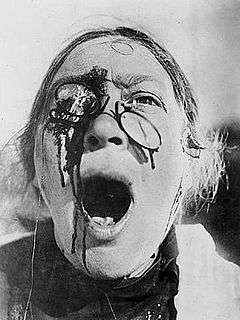
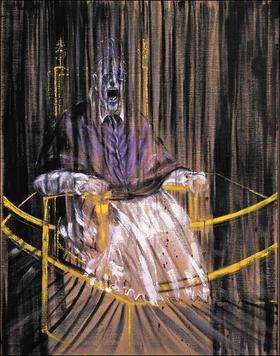
The inspiration for the recurring motif of screaming mouths in many Bacons of the late 1940s and early 1950s was drawn from a number of sources, including medical text books, the works of Matthias Grünewald[52] and photographic stills of the nurse in the Odessa Steps scene in Sergei Eisenstein's 1925 silent Battleship Potemkin. Bacon saw the film in 1935, and viewed it frequently thereafter. He kept in his studio a photographic still of the scene, showing a close-up of the nurse's head screaming in panic and terror and with broken pince-nez spectacles hanging from her blood-stained face. He referred to the image throughout his career, using it as a source of inspiration.[53]
Bacon described the screaming mouth as a catalyst for his work, and incorporated its shape when painting the chimera. His use of the of the motif can be seen in one of his first surviving works,[54] Abstraction from the Human Form. By the early 1950s it became an obsessive concern, to the point, according to art critic and Bacon biographer Michael Peppiatt, "it would be no exaggeration to say that, if one could really explain the origins and implications of this scream, one would be far closer to understanding the whole art of Francis Bacon."[55]
Legacy
Estate assignment
In 1999, England's High Court ruled that Marlborough Fine Art had to be replaced by a new independent representative for the Bacon estate.[56] The estate moved its business to Faggionato Fine Arts in Europe and Tony Shafrazi in New York.[57] That same year, the estate sued Marlborough UK and Marlborough International, Vaduz, charging them with wrongfully exploiting Bacon in a relationship that was manifestly disadvantageous to him until his death in 1992, and to his estate. The suit alleged Marlborough in London grossly underpaid Bacon for his works and resold them through its Liechtenstein branch at much higher prices. It contended that Marlborough never supplied a complete accounting of Bacon's works and sales and that Marlborough handled some works it has never accounted for.[58] The suit was dropped in early 2002 when both sides agreed to pay their own costs and Marlborough released all its documents about Bacon.[59] In 2003, the estate was handed to a four-person trust based in Jersey.[60]
Reece Mews studio
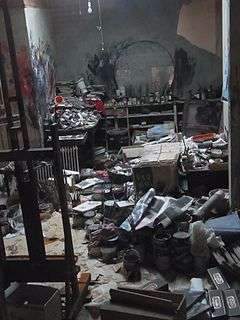
In August 1998 the Hugh Lane Gallery, Dublin, acquired and moved the studio and its entire contents from London to Dublin. The move involved both art historians and archaeologists who made the survey and elevation drawings of the studio, mapping out the spaces and locations of the objects.
Conservators and curators tagged and packed each of the items, including the walls, doors, floor, ceiling and dust. The relocated studio opened in 2001. Over 7,000 items were catalogued on a specially designed database, the first computerised archive of the entire contents of a world ranking artist's studio. Every item in the studio has a database entry. Each entry consists of an image and a factual account of an object. The database has entries on approximately 570 books and catalogues, 1,500 photographs, 100 slashed canvases, 1,300 leaves torn from books, 2,000 artist's materials and 70 drawings. Other categories include the artist's correspondence, magazines, newspapers and vinyl records.
Posthumous auction history
The Popes and large triptychs, in their time, commanded the highest prices at auction.[57] By 1989 Bacon was the most expensive living artist after one of his triptychs sold at Sotheby's for over $6 million. In 2007, actress Sophia Loren consigned Study for Portrait II (1956) from the estate of her late husband Carlo Ponti at Christie's.[61] It was auctioned for the then record price of £14.2 million ($27.5 million).[62]
On 14 May 2008, the Triptych, 1976, sold at Sotheby's for €55.465 million ($86.28 million), then a record for the artist and the highest price paid for a postwar work of art at auction up to 2008. On 13 November 2013, Three Studies of Lucian Freud sold at Christie's New York for $142.4 million, surpassing both Triptych and 1976 in auctioned value, and more importantly claiming the record for highest auction price of a work of art at that time, a title previously held by the fourth version of Edvard Munch's Scream and now held by Willem de Kooning's Interchange. In September 2015 David Geffen sold de Kooning's oil painting Interchange for $300 million to hedge fund billionaire Ken Griffin.[63]
Catalogue raisonné
A first, incomplete catalogue raisonné was compiled by curator Ronald Alley in 1964.[64] In 2016, a five-volume Francis Bacon: Catalogue Raisonné, documenting 584 paintings by Bacon, was released by Martin Harrison and others.[64]
Harrison's Catalogue Raisonne summaried the artist's motivations when he gifted the second version of his triptych of the Crucifixion to the Tate in 1991. "This reprise of the painting Bacon considered his 'Opus I' is both larger and more monumental that the original, the sumptuous, dusky crimson backgrounds and deep space evoking a subverted Baroque altarpiece. Conscious no doubt of his artistic legacy, Bacon intended a posthumous bequest of the painting to the Tate; he was persuaded to bring forward the donation and, on condition there should be no ceremony, gifted it to the gallery in 1991."
References
Notes
- ↑ Schmied (1996), 121
- ↑ "Horrible!", The Guardian, Saturday 30 August 2008.
- ↑ Robert Hughes, The Shock of the New – Episode 6 – "The View from the Edge" – 21 September 1980 – BBC.
- ↑ Some had appeared in black-and-white photographs in the late 1950s Catalogue Raisonné
- ↑ Tate. "Francis Bacon (1909–1992) – Tate". Retrieved 29 January 2017.
- ↑ francis-bacon.com; Retrieved 11 August 2013
- ↑ Peppiatt (1996), 4
- 1 2 "Bacon family's 1911 census form details". Census.nationalarchives.ie. Retrieved 26 September 2011.
- ↑ "I was told by a homosexual friend of Francis' that he'd once admitted that his father, the dreaded and failed horse trainer, had arranged that his small son spend his childhood being systematically and viciously horsewhipped by his Irish grooms.", Caroline Blackwood, Francis Bacon (1909–1992), The New York Review of Books Volume 39, No. 15, 24 September 1992
- ↑ "I'm not sure Francis had a lot in common with my mother, because she didn't take much notice of his art or anything. I remember sometimes he brought home things that he'd drawn and, I don't know what my mother did with them she wasn't wildly interested in it. They were always, what we used to call 1920s ladies you know, with the cloche hat and, cigarette holder [gestures long holder]. That sort of thing. They were always drawings like that. They were very nice. What happened to them I don't know. – And, funnily enough I actually remember them." – Ianthe Knott (née Bacon) interviewed for Bacon's Arena dir. Adam Low (BBC Arena), broadcast 19 March 2005, at 9 pm on BBC2.
- ↑ Peppiatt, Michael (2015). "Conversations at Night". Francis Bacon in Your Blood: A Memoir. United Kingdom: Bloomsbury. ISBN 978-1-4088-5624-6.
- ↑ Peppiatt (1996), 32
- ↑ "The replies used to pour in, and my old nanny used to go through them all and pick out the best ones. I must say she was always right. There was one time I found myself being taken back to Paris by this dreadful old thing who took a very expensive flat just off the Champs-Élysées, on the rue 1er de Serbie. I didn't stay with him long, as you might imagine! But what was amazing was how easily you were able to pick up people in that way." – quoted in Peppiatt, 55
- ↑ Peppiatt, Michael. Francis Bacon: Anatomy of an Enigma. New York, Farrar, Straus and Giroux, 1996
- ↑ "Another thing that made me think about the human cry was a book I bought when I was very young from a bookshop in Paris, a second-hand book with beautiful hand-coloured plates of anatomical diseases of the mouth, beautiful plates of the mouth open and of the examination of the inside of the mouth; and they fascinated me, and I was obsessed by them. And then I saw – or perhaps I even knew by then – the Potemkin film, and I attempted to use the Potemkin still as a basis on which I could also use these marvellous illustrations of the human mouth. It never worked out though." — from interview 2 (May 1966) (Interviews with Francis Bacon David Sylvester)
- ↑ Schmied (1996), 121
- ↑ "Landscape with Car". Christies, 2007. Retrieved June 2017
- ↑ Bragg, Melvyn. "Francis Bacon". South Bank Show. BBC documentary film, first aired 9 June 1985.
- ↑ Russell (1971), 22
- ↑ Wrathall, Claire (6 July 2016). "Francis Bacon's Monaco magic is highlighted in a new exhibition". The Telegraph. Retrieved 2016-10-22.
- ↑ Letter by Bacon to G. Sutherland, 30 December 1946, Monte Carlo, National Galleries and Museums of Wales
- ↑ C. Jacobi, "Cat's Cradle – Francis Bacon and the Art of 'Isabel Rawsthorne'", Visual Culture in Britain (special Bacon issue); ed. D Mellor and Y Holt, 10. 3, 293—314; ISSN 1750-0133 (electronic), 1355–5502 (paper)
- ↑ Francis Bacon Archived 27 January 2013 at Archive.is L&M Arts, New York / Los Angeles.
- ↑ Listener, 17 November 1949
- ↑ Peppiatt, 148
- ↑ 31 April in Peppiatt, the Estate has 30 April
- ↑ Michael Shnayerson (August 2000), Francis Bacon’s Tangled Web Vanity Fair.
- ↑ "Consumed by his own Effigy: George Dyer's Relationship with Francis Bacon on Sotheby's Blog". Retrieved 29 January 2017.
- ↑ Akbar, Arifa. "Inside the Mind of Francis Bacon". The Independent (London), 25 April 2007. Retrieved 29 July 2007.
- ↑ Heaney, Joe. "Love is the Devil". Gay Times, September 2006
- 1 2 Peppiatt (1996), 211
- ↑ Harrison, Martin. "Francis Bacon: lost and found". Apollo Magazine, 1 March 2005
- ↑ Peppiatt (1996), 213
- ↑ Peppiatt (1996), 214
- ↑ Peppiatt (1996), 215
- ↑ Norton, James. "The six loves of Francis Bacon". Sunday Herald, 13 March 2005.
- ↑ "George Dyer" Archived 5 December 2008 at the Wayback Machine. Gemeentemuseum Den Haag, 2001. Retrieved 29 July 2007.
- ↑ "Francis Bacon: A Brush with Violence". bbc.co.uk. 28 January 2017. Retrieved 29 January 2017.
- ↑ Russell (1970), 151
- ↑ Russell (1971), 178
- ↑ Russell (1970), 179
- ↑ Peppiatt (1996), 243
- ↑ Ficacci, 94
- ↑ "Dublin City Gallery The Hugh Lane, Francis Bacon Studio, History of Studio Relocation". Hughlane.ie. Retrieved 26 September 2011.
- ↑ Kennedy, Maev; arts; correspondent, heritage (8 February 2001). "Disputed Bacon art works go on display". Retrieved 29 January 2017 – via The Guardian.
- ↑ For his relation to Deleuze, the body and religion, see Francis Sanzaro's "A Review of Francis Bacon: A Centenary Review at the Metropolitan Museum of Art" in Comparative and Continental Philosophy vol. 1 no. 2 (2009): 279–85
- ↑ Russell, 113
- 1 2 Schmied, 78
- 1 2 Sylvester, 13
- ↑ Davies & Yard, 12
- ↑ Bürger, Peter. In Zweite (2006), 30
- ↑ Schmied, 73
- ↑ Davies
- ↑ Throughout his career, Bacon destroyed a great many of his paintings
- ↑ Peppiatt, 24
- ↑ Warren Hoge (23 March 1999), Court Cuts Gallery's Ties To Francis Bacon Estate New York Times.
- 1 2 Sarah Thornton (29 August 2008), Francis Bacon claims his place at the top of the market The Art Newspaper.
- ↑ Judith H. Dobrzynski (20 April 2000), Dadaist's Heirs Also Fight Marlborough Over Estate New York Times.
- ↑ Alan Riding (7 March 2003), John Edwards, 53, Francis Bacon Confidant New York Times.
- ↑ Henry Samuel (21 April 2010), Francis Bacon heirs battle Van Gogh foundation The Daily Telegraph.
- ↑ Colin Gleadell (30 January 2007), Art sales: Sophia Loren's slice of Bacon The Daily Telegraph
- ↑ [s.n.] (9 February 2007). Bacon portrait breaks sale record. BBC. Accessed September 2013.
- ↑ "Billionaire drops $500M for 2 masterpieces," Feb. 19, 2016, Bloomberg News, as republished by Fox News, at .
- 1 2 Alexander Adams (July 21, 2016), All together now: on the Francis Bacon catalogue raisonné Archived 29 July 2016 at the Wayback Machine. The Art Newspaper.
Bibliography
- Archimbaud, Michel. Francis Bacon: The Final Vision. New York: Phaidon Press, 1994. ISBN 0-7148-2983-8
- Bacon, Francis. Francis Bacon: Important Paintings from the Estate. New York: Tony Shafrazi gallery, 1998. ISBN 1-891475-16-9
- Baldassari, Anne. Bacon-Picasso: The Life of Images. London: Flammarion, 2005. ISBN 2-08-030486-0
- Brighton, Andrew. Francis Bacon. London: Tate Publishing, 2001. ISBN 1-85437-307-2
- Cappock, Margarita. Francis Bacon's Studio. London: Merrell Publishers, 2005. ISBN 1-85894-276-4
- Deleuze, Gilles. Francis Bacon: The Logic of Sensation. Paris: Continuum International Publishing- Mansell, 2004. ISBN 0-8264-7318-0
- Domino, Christophe. Francis Bacon. London: Thames and Hudson, 1997. ISBN 0-500-30076-3
- Edwards, John. 7 Reece Mews: Francis Bacon's Studio. London: Thames & Hudson, 2001. ISBN 0-500-51034-2
- Farson, Daniel. The Gilded Gutter Life of Francis Bacon. London: Vintage, 1994. ISBN 0-09-930781-2
- Gale, Matthew & Sylvester David. Francis Bacon: Working on Paper London: Tate Publishing, 1999. ISBN 1-85437-280-7
- Hammer, Martin. Bacon and Sutherland. Boston: Yale University Press, 2005. ISBN 0-300-10796-X
- Hammer, Martin. Francis Bacon: Portraits and Heads. Edinburgh: National Galleries of Scotland, 2005. ISBN 1-903278-66-X
- Harrison, Martin. In Camera, Francis Bacon: Photography, Film and the Practice of Painting. Thames & Hudson, 2005. ISBN 0-500-23820-0
- Harrison, Martin; Daniels, Rebecca. Francis Bacon Incunabula. London: Thames & Hudson, 2009. ISBN 978-0-500-09344-3
- Kundera, Milan & Borel, France. Bacon: Portraits and Self-portraits. London: Thames & Hudson, 1996. ISBN 0-500-09266-4
- Peppiatt, Michael. Francis Bacon: Anatomy of an Enigma. London: Weidenfeld & Nicolson, 1996. ISBN 0-297-81616-0
- Peppiatt, Michael. Francis Bacon in the 1950s. London: Yale University Press, 2006. ISBN 0-300-12192-X
- Rothenstein, John (intro); Alley, Ronald. Catalogue raisonnè and documentation, 1964. Francis Bacon. Thames and Hudson
- Russell, John. Francis Bacon. London: Thames and Hudson, 1993. ISBN 0-500-20271-0
- Sabatier, Bruno. "The Complete Graphic Work, Catalogue Raisonné", Paris, JSC Gallery, 2012.
- Schmied, Wieland. Francis Bacon: Commitment and Conflict. London: Prestel Verlag, 2006. ISBN 3-7913-3472-7
- Sinclair, Andrew Francis. Bacon: His Life and Violent Times. London, Sinclair Stevenson, 1993; New York, Crown
- Steffen, Barbara; Bryson, Norman. Francis Bacon and the Tradition of Art. Zurich: Skira Editore, 2004. ISBN 88-8491-721-2
- Sylvester, David. Interviews with Francis Bacon. London: Thames & Hudson, 1987. ISBN 0-500-27475-4
- Sylvester, David. Looking Back at Francis Bacon. London: Thames & Hudson, 2000. ISBN 0-500-01994-0
- Sylvester, David. Francis Bacon: The Human Body. London: Hayward Gallery, 1998. ISBN 1-85332-175-3
- Sylvester, David. About Modern Art: Critical Essays 1948–2000. London: Pimlico, 2002. ISBN 0-7126-0563-0
- Todoli, Vincente. Francis Bacon: Caged. Uncaged. Lisbon: Fundacao De Serralves, 2003. ISBN 972-739-109-5
- Van Alphen, Ernst. Francis Bacon and the Loss of Self. London: Reaktion Books, 1992. ISBN 0-948462-34-5
- Zweite, Armin. Francis Bacon: The Violence of the Real. London: Thames and Hudson, 2006. ISBN 0-500-09335-0
Further reading
- Akerman, Mariano (2012). "Bacon: Painter with a double-edged sword", Blue Chip Magazine, Vol. LXXXVIII, N°8, February–March 2012, pp. 29–33; available online.
- Chare, Nicholas (2012). After Francis Bacon: Synaesthesia and Sex in Paint. London: Ashgate.
- Davis, Ben. "Bacon Half-Baked". Artnet artnet.com. Retrieved 27 December 2015.
External links
| Wikiquote has quotations related to: Francis Bacon (artist) |
| Wikimedia Commons has media related to Francis Bacon (artist). |

